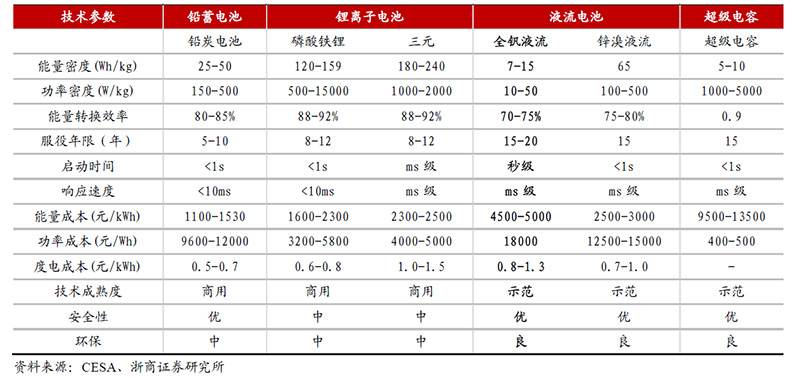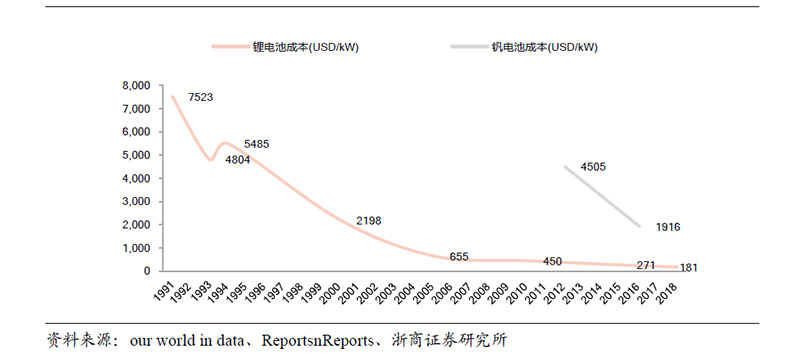Among all kinds of energy storage batteries, vanadium flow battery has obvious advantages:
1) High safety: vanadium battery has no potential explosion and fire hazard. The active substance of vanadium battery is stored in liquid form in the liquid storage tank outside the stack. The flowing active substance can minimize the concentration polarization. Even if the positive and negative electrolyte are mixed, there is no danger, but the temperature of electrolyte rises slightly. In addition, all its components are basically immersed in the solution, and the heat dissipation is supported by the solution. At the same time, due to the open system, there will be no such problem as thermal runaway of lithium batteries.
2) The upper limit of energy storage is high and controllable: the battery capacity depends on the amount of external active solution. By increasing the volume of electrolyte, the energy storage capacity of vanadium battery can be increased at will. Compared with lithium battery, it is very scalable and easy to adjust.
3) High power: the power of vanadium battery can be increased by increasing the number of single-chip batteries and electrode area, and increasing the concentration of electrolyte.
4) High efficiency: due to the high catalytic activity of vanadium battery electrode, positive and negative active substances are stored in positive and negative electrolyte storage tanks respectively, avoiding the self discharge consumption of positive and negative active substances. It can be maintained for a long time after full charge, with extremely low self discharge rate, and self discharge can be almost ignored. The efficiency of charge discharge energy conversion vanadium battery is more than 75%.
5) Long service life: Since the positive and negative active substances of vanadium battery only exist in the positive and negative electrolyte respectively, there is no complex solid phase reaction during charging and discharging, so the battery has a long service life. It can withstand high current charging and discharging, and can conduct deep discharge without damaging the battery. The number of cycles is ≥ 13000 times, and the service life of the battery can reach 15-20 years.
6) Fast response speed: vanadium battery pack starts instantly when it is full of electrolyte. During operation, it only takes 0.02 seconds for charging and discharging state switching, and the response speed is 1 ms.
7) Convenient charging: the vanadium battery can be charged instantaneously by directly changing the electrolyte.
8) Environmentally friendly: Compared with the commonly used lead-acid batteries, the total emission during the life cycle of the battery is only 7-25% during static operation; The electrolyte can be replaced and recycled. The ionic membrane does not need precious metals as electrode catalysts. The electrode materials are mostly carbon materials.
9) Convenient placement: The vanadium battery can operate in a fully automatic closed mode. It has no pollution to the outside world during normal operation. It has a large degree of freedom in installation and positioning. It has no high requirements on the installation environment except for temperature.
On the other hand, vanadium battery also has obvious disadvantages:
1) Large volume and mass: limited by the upper limit of ion solubility in electrolyte, vanadium battery has low specific energy density, and technology is difficult to break through. The volume of vanadium battery with the same energy can reach 3-5 times that of lithium battery, and the mass can reach 2-3 times. Therefore, vanadium batteries can only be used in static energy storage systems, and are difficult to be used in electric vehicles, electronic products and other fields.
2) Ambient temperature requirements: vanadium batteries usually work at 0-45 ℃. Too low temperature will cause the electrolyte to solidify, while too high temperature will cause V5+in the solution to form V2O5, which will block the electrolyte channel and lead to battery scrapping.
3) High requirements for by-product treatment: raw materials of electrolyte, positive precipitation and thin layer formed by air drying of leaked positive solution all have the same thing, namely V2O5, which is a highly toxic chemical.
4) High cost and high maintenance cost: the cost is high. At present, only the material cost of 5kW vanadium battery can reach more than 400000; Under normal use, the maintenance is carried out by professionals every two months. High frequency maintenance makes it difficult to be widely used on the user side.

Fig. 1 Technical route and parameter comparison of energy storage battery
The cost of vanadium battery needs to be solved urgently
At present, the cost problem is still the biggest challenge facing the large-scale commercial application of vanadium batteries. As it has not been commercialized on a large scale, and is subject to equipment, capacity and high initial investment, the cost of vanadium batteries is about 2-3 times that of lithium batteries. At the current container delivery price (including battery pack, temperature control system, converter system, fire protection system, monitoring system, etc.), the current cost of vanadium flow battery is 3-3.2 yuan/Wh. Compared with the current cost of lithium ion battery for energy storage, which is about 1.2-1.5 yuan/Wh, vanadium battery still faces huge price pressure. With the promotion of policies, the cost of vanadium batteries is expected to further decline after the formation of large-scale and clustered industries.

Fig. 2 The cost of vanadium battery and lithium battery is declining